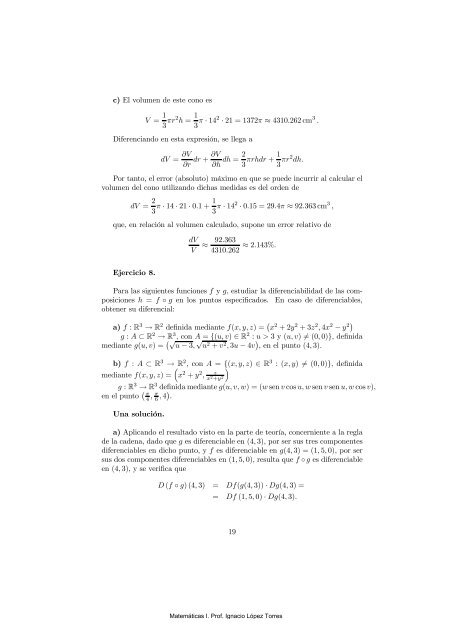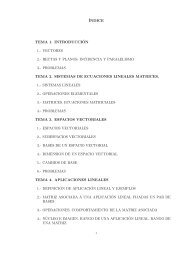ejercicios de cálculo diferencial en funciones de varias variables
ejercicios de cálculo diferencial en funciones de varias variables
ejercicios de cálculo diferencial en funciones de varias variables
You also want an ePaper? Increase the reach of your titles
YUMPU automatically turns print PDFs into web optimized ePapers that Google loves.
c) Elvolum<strong>en</strong><strong>de</strong>esteconoes<br />
= 1<br />
3 2 = 1<br />
3 · 142 · 21 = 1372 ≈ 4310262 cm 3 .<br />
Difer<strong>en</strong>ciando <strong>en</strong> esta expresión, se llega a<br />
= <br />
+<br />
<br />
2 1<br />
= +<br />
3 3 2. Por tanto, el error (absoluto) máximo <strong>en</strong> que se pue<strong>de</strong> incurrir al calcular el<br />
volum<strong>en</strong> <strong>de</strong>l cono utilizando dichas medidas es <strong>de</strong>l or<strong>de</strong>n <strong>de</strong><br />
= 2<br />
· 14 · 21 · 01+1<br />
3 3 · 142 · 015 = 294 ≈ 92363 cm 3 ,<br />
que, <strong>en</strong> relación al volum<strong>en</strong> calculado, supone un error relativo <strong>de</strong><br />
Ejercicio 8.<br />
<br />
<br />
92363<br />
≈ ≈ 2143%.<br />
4310262<br />
Para las sigui<strong>en</strong>tes <strong>funciones</strong> y , estudiar la difer<strong>en</strong>ciabilidad <strong>de</strong> las composiciones<br />
= ◦ <strong>en</strong> los puntos especificados. En caso <strong>de</strong> difer<strong>en</strong>ciables,<br />
obt<strong>en</strong>er su <strong>difer<strong>en</strong>cial</strong>:<br />
a) : R 3 → R 2 <strong>de</strong>finida mediante ( ) = ¡ 2 +2 2 +3 2 4 2 − 2¢<br />
: ⊂ R 2 → R 3 ,con = {( ) ∈ R 2 : 3 y ( ) 6= (0 0)}, <strong>de</strong>finida<br />
mediante ( ) = ¡√ − 3 √ 2 + 2 3 − 4 ¢ , <strong>en</strong> el punto (4 3).<br />
b) : ⊂ R3 → R2 ,con = {( ) ∈ R3 ³<br />
:( ) 6= (00)}, <strong>de</strong>finida<br />
mediante ( ) = 2 + 2 2 +2 ´<br />
: R3 → R3 <strong>de</strong>finida mediante ( ) =(s<strong>en</strong> cos s<strong>en</strong> s<strong>en</strong> cos ),<br />
<strong>en</strong> el punto ¡ <br />
4 6 4¢ .<br />
Una solución.<br />
a) Aplicando el resultado visto <strong>en</strong> la parte <strong>de</strong> teoría, concerni<strong>en</strong>te a la regla<br />
<strong>de</strong> la ca<strong>de</strong>na, dado que es difer<strong>en</strong>ciable <strong>en</strong> (4 3), por ser sus tres compon<strong>en</strong>tes<br />
difer<strong>en</strong>ciables <strong>en</strong> dicho punto, y es difer<strong>en</strong>ciable <strong>en</strong> (4 3) = (1 5 0), porser<br />
sus dos compon<strong>en</strong>tes difer<strong>en</strong>ciables <strong>en</strong> (1 5 0), resultaque ◦ es difer<strong>en</strong>ciable<br />
<strong>en</strong> (4 3), yseverifica que<br />
( ◦ )(43) = ((4 3)) · (4 3) =<br />
= (1 5 0) · (4 3).<br />
19<br />
Matemáticas I. Prof. Ignacio López Torres



